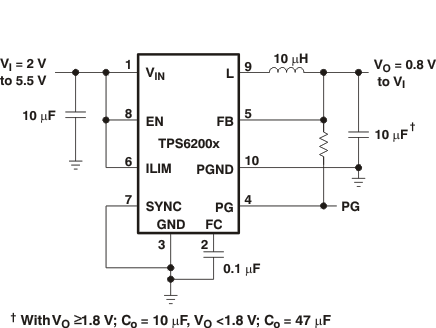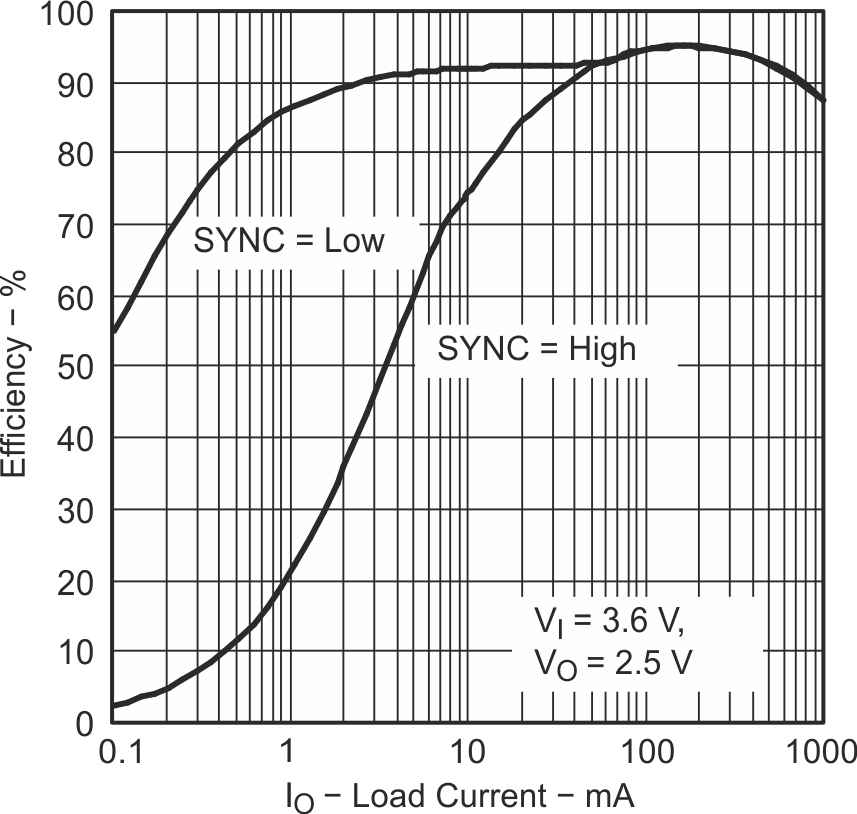SLVS294F September 2000 – August 2015 TPS62000 , TPS62002 , TPS62003 , TPS62004 , TPS62005 , TPS62006 , TPS62007 , TPS62008
PRODUCTION DATA.
- 1 Features
- 2 Applications
- 3 Description
- 4 Revision History
- 5 Device Comparison Table
- 6 Pin Configuration and Functions
- 7 Specifications
- 8 Detailed Description
-
9 Application and Implementation
- 9.1 Application Information
- 9.2 Typical Application
- 9.3
System Examples
- 9.3.1 Standard 5-V to 3.3-V/600-mA Conversion; High Efficiency
- 9.3.2 Single Li-ion to 2.5-V/600-mA Using Ceramic Capacitors Only
- 9.3.3 Single Li-ion to 1.8 V/300 mA; Smallest Solution Size
- 9.3.4 Dual Cell NiMH or NiCd to 1.2 V/200 mA; Smallest Solution Size
- 9.3.5 Dynamic Output Voltage Programming As Used in Low Power DSP Applications
- 10Power Supply Recommendations
- 11Layout
- 12Device and Documentation Support
- 13Mechanical, Packaging, and Orderable Information
Package Options
Refer to the PDF data sheet for device specific package drawings
Mechanical Data (Package|Pins)
- DGS|10
Thermal pad, mechanical data (Package|Pins)
Orderable Information
1 Features
- High-Efficiency Synchronous Step-Down Converter with More than 95% Efficiency
- 2-V to 5.5-V Operating Input Voltage Range
- Adjustable Output Voltage Range From 0.8 V to VIN
- Fixed Output Voltage Options Available in 0.9 V, 1 V, 1.2 V, 1.5 V, 1.8 V, 1.9 V, 2.5 V, and 3.3 V
- Synchronizable to External Clock Signal up to
1 MHz - Up to 600 mA Output Current
- Pin-Programmable Current Limit
- High Efficiency Over a Wide Load Current Range in Power Save Mode
- 100% Maximum Duty Cycle for Lowest Dropout
- Low-Noise Operation Antiringing Switch and PFM/PWM Operation Mode
- Internal Softstart
- 50-μA Quiescent Current (TYP)
- Available in the 10-Pin Microsmall Outline Package (VSSOP)
- Evaluation Module Available
2 Applications
- Low-Power CPUs and DSPs
- Cellular Phones
- Organizers, PDAs, and Handheld PCs
- MP-3 Portable Audio Players
- Digital Cameras
- USB-Based DSL Modems and Other Network Interface Cards
3 Description
The TPS6200x devices are a family of low-noise synchronous step-down DC/DC converters that are ideally suited for systems powered from a 1-cell Li-ion battery or from a 2- to 3-cell NiCd, NiMH, or alkaline battery. The TPS6200x operates typically down to an input voltage of 1.8 V, with a specified minimum input voltage of 2 V.
The TPS62000 operates over a free-air temperature range of –40°C to 85°C.The device is available in the 10-pin (DGS) microsmall outline package (VSSOP).
Device Information(1)
| PART NUMBER | PACKAGE | BODY SIZE (NOM) |
|---|---|---|
| TPS6200x | VSSOP (10) | 3.00 mm × 3.00 mm |
- For all available packages, see the orderable addendum at the end of the datasheet.
3.0.0.1 Typical Application Schematic

3.0.0.2 Efficiency vs Load Current
